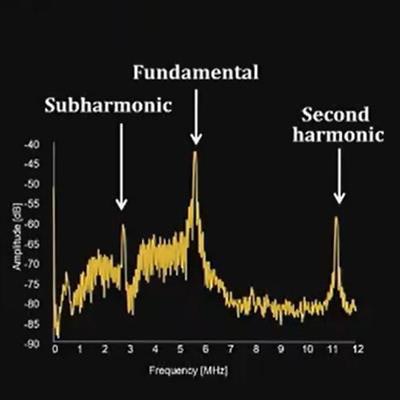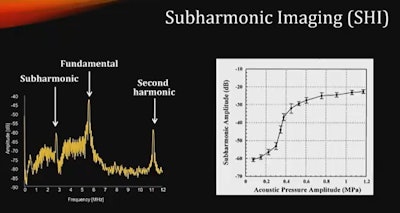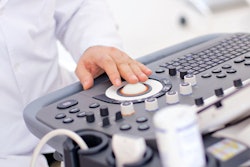
3D subharmonic ultrasound is better at detecting contrast flow in vascular breast masses than 3D harmonic ultrasound, according to research presented by Flemming Forsberg, PhD, at the RSNA 2021 annual meeting.
Forsberg, from Thomas Jefferson University in Philadelphia, presented his team's findings, which also showed that characterizing indeterminate breast lesions with quantitative 3D subharmonic imaging parameters and clinical assessments improves diagnostic accuracy.
"If you add the quantitative parameters together, you increase your accuracy and end up in the 90% to 95% range," Forsberg said.
Harmonic imaging is widely available, with previous research touting its ability to provide better-quality images than conventional ultrasound. However, in a review in Ultrasonics in 2000, Forsberg said that harmonic imaging is associated with problems due to second-harmonic generation and accumulation within the tissue itself.
He said subharmonic imaging, which works by imaging microbubble ultrasound contrast agents, should have much better lateral resolution and may work well in scanning structures deep in the body. In theory, this is because of the higher transmit frequency and the smaller attenuation of scattered subharmonic signals.
In their current study, Forsberg et al wanted to assess the ability of contrast-enhanced nonlinear 3D harmonic and subharmonic imaging to characterize suspicious breast lesions using clinical assessments by radiologists and quantitative parameters.
The team looked at data from 219 women who were successfully scanned, including 55 malignant cases. All women went on to have a breast biopsy and pathology assessments were used as the reference standard. Five independent radiologists scored the performance of the different ultrasound modes, and diagnosis was assessed on a seven-point BI-RADS scale.
Sufficient ultrasound contrast agent flow was seen in 83 lesions through subharmonic imaging, but only in eight lesions through harmonic imaging.
 3D subharmonic ultrasound has been touted by researchers as providing better-quality images due to its higher transmit frequency and smaller attenuation of scattered subharmonic signals. Researchers from Thomas Jefferson University in Philadelphia found that subharmonic imaging is better at detecting contrast flow in vascular breast masses than 3D harmonic ultrasound, though both performed better than standard mammography in terms of accuracy. Image courtesy of Fleming Forsberg, PhD.
3D subharmonic ultrasound has been touted by researchers as providing better-quality images due to its higher transmit frequency and smaller attenuation of scattered subharmonic signals. Researchers from Thomas Jefferson University in Philadelphia found that subharmonic imaging is better at detecting contrast flow in vascular breast masses than 3D harmonic ultrasound, though both performed better than standard mammography in terms of accuracy. Image courtesy of Fleming Forsberg, PhD.Subharmonic imaging depicted more anastomoses and vascularity than harmonic imaging (p < 0.021), but the researchers found no differences in terms of pathology. Ultrasound modes achieved accuracies ranging from 79% to 85%, significantly better than the 72% seen in mammography (p < 0.03).
Subharmonic imaging also increased diagnostic confidence by 3% to 6% (p < 0.01), but inter-reader agreements were medium to low, the authors found. The best logistical regression model achieved a 96% accuracy by combining clinical reads and quantitative 3D subharmonic imaging parameters.
"It was a little bit disappointing that for the clinical readers alone, there was no significant improvement by going to the 3D subharmonic and harmonic mode relative to conventional modes," Forsberg said. "With that said, we still think we're relatively on target with this and can get something decent out of it."



















